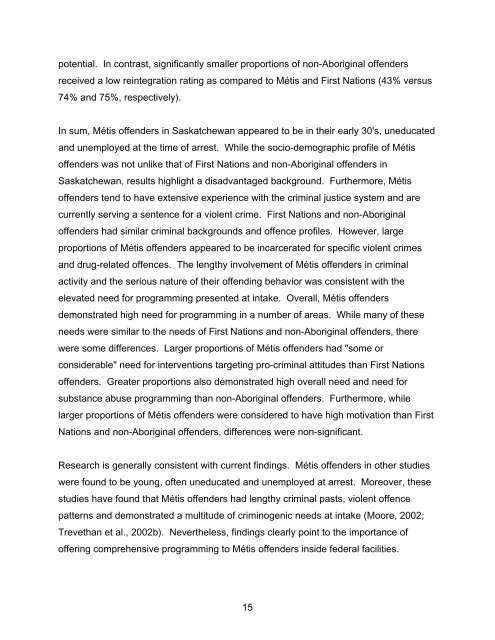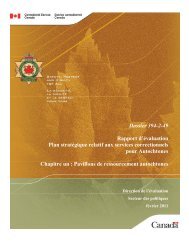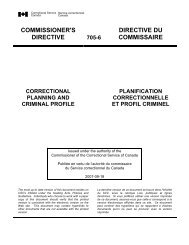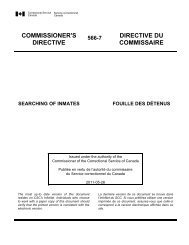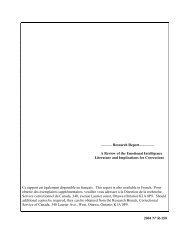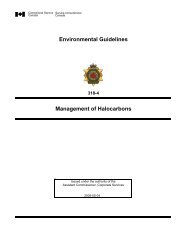Program and Service Needs of Federally Incarcerated Métis ...
Program and Service Needs of Federally Incarcerated Métis ...
Program and Service Needs of Federally Incarcerated Métis ...
You also want an ePaper? Increase the reach of your titles
YUMPU automatically turns print PDFs into web optimized ePapers that Google loves.
potential. In contrast, significantly smaller proportions <strong>of</strong> non-Aboriginal <strong>of</strong>fenders<br />
received a low reintegration rating as compared to <strong>Métis</strong> <strong>and</strong> First Nations (43% versus<br />
74% <strong>and</strong> 75%, respectively).<br />
In sum, <strong>Métis</strong> <strong>of</strong>fenders in Saskatchewan appeared to be in their early 30's, uneducated<br />
<strong>and</strong> unemployed at the time <strong>of</strong> arrest. While the socio-demographic pr<strong>of</strong>ile <strong>of</strong> <strong>Métis</strong><br />
<strong>of</strong>fenders was not unlike that <strong>of</strong> First Nations <strong>and</strong> non-Aboriginal <strong>of</strong>fenders in<br />
Saskatchewan, results highlight a disadvantaged background. Furthermore, <strong>Métis</strong><br />
<strong>of</strong>fenders tend to have extensive experience with the criminal justice system <strong>and</strong> are<br />
currently serving a sentence for a violent crime. First Nations <strong>and</strong> non-Aboriginal<br />
<strong>of</strong>fenders had similar criminal backgrounds <strong>and</strong> <strong>of</strong>fence pr<strong>of</strong>iles. However, large<br />
proportions <strong>of</strong> <strong>Métis</strong> <strong>of</strong>fenders appeared to be incarcerated for specific violent crimes<br />
<strong>and</strong> drug-related <strong>of</strong>fences. The lengthy involvement <strong>of</strong> <strong>Métis</strong> <strong>of</strong>fenders in criminal<br />
activity <strong>and</strong> the serious nature <strong>of</strong> their <strong>of</strong>fending behavior was consistent with the<br />
elevated need for programming presented at intake. Overall, <strong>Métis</strong> <strong>of</strong>fenders<br />
demonstrated high need for programming in a number <strong>of</strong> areas. While many <strong>of</strong> these<br />
needs were similar to the needs <strong>of</strong> First Nations <strong>and</strong> non-Aboriginal <strong>of</strong>fenders, there<br />
were some differences. Larger proportions <strong>of</strong> <strong>Métis</strong> <strong>of</strong>fenders had "some or<br />
considerable" need for interventions targeting pro-criminal attitudes than First Nations<br />
<strong>of</strong>fenders. Greater proportions also demonstrated high overall need <strong>and</strong> need for<br />
substance abuse programming than non-Aboriginal <strong>of</strong>fenders. Furthermore, while<br />
larger proportions <strong>of</strong> <strong>Métis</strong> <strong>of</strong>fenders were considered to have high motivation than First<br />
Nations <strong>and</strong> non-Aboriginal <strong>of</strong>fenders, differences were non-significant.<br />
Research is generally consistent with current findings. <strong>Métis</strong> <strong>of</strong>fenders in other studies<br />
were found to be young, <strong>of</strong>ten uneducated <strong>and</strong> unemployed at arrest. Moreover, these<br />
studies have found that <strong>Métis</strong> <strong>of</strong>fenders had lengthy criminal pasts, violent <strong>of</strong>fence<br />
patterns <strong>and</strong> demonstrated a multitude <strong>of</strong> criminogenic needs at intake (Moore, 2002;<br />
Trevethan et al., 2002b). Nevertheless, findings clearly point to the importance <strong>of</strong><br />
<strong>of</strong>fering comprehensive programming to <strong>Métis</strong> <strong>of</strong>fenders inside federal facilities.<br />
15


